What dangerous animals might be in Washington, the state in the far Northwest corner of the lower 48 states? Washington has a variety of habitats including the Cascade Mountains, Puget Sound, the Pacific Coast, and Columbia River. There are also acres of National forests. Are there grizzly bears in the mountains? Sharks off the coast? What about giant octopuses in Puget Sound? “Murder Hornets” sound dangerous, but are they really murderers? Let’s find out about some of the most dangerous animals in Washington.
Are there sharks off the coast of Washington?
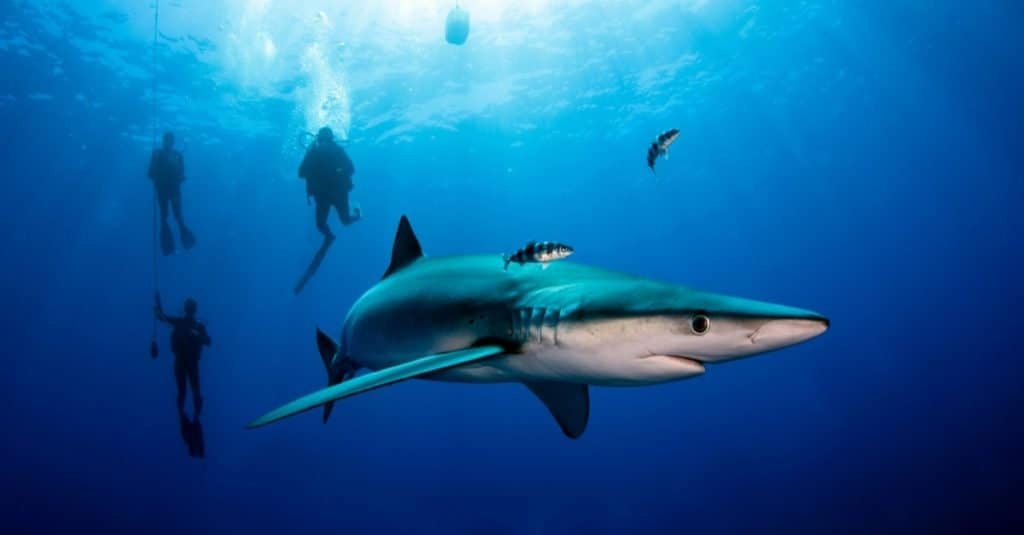
Blue sharks are one of the most common shark off the coast of Washington. They can be 10-13 feet long.
©Vladislav Klimin/Shutterstock.com
- Blue sharks: common shark found off the coast, blue on the top and white underneath, can reach 10-13 feet long, can swim 25mph
- Salmon sharks: most salmon sharks are 6-8 feet long, sometimes mistaken for Great White sharks, prefer to eat salmon than attack humans
- Great White sharks: most aggressive shark off the coast, can reach 20 feet in length, responsible for the most human attacks world wide
Reported shark attacks in Washington state
Sharks are dangerous animals but there have only been two attacks off the coast of Washington since 1989. One occurred with a great white shark that attacked a man that was surfing off Grays Harbor County and the second happened in the same area in 2017. Both attacks were considered unprovoked.
Are there sharks in Puget Sound?
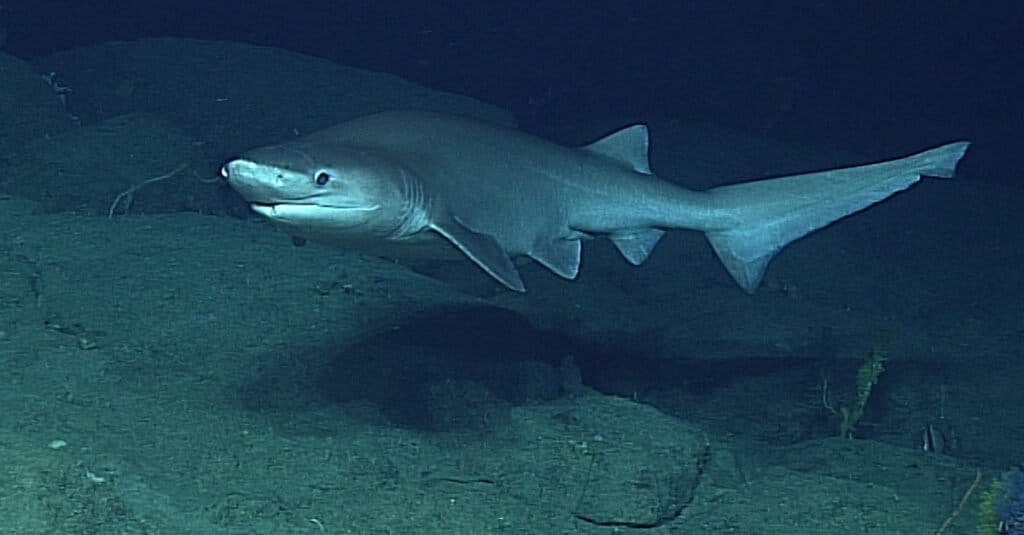
Sixgill sharks generally live in deep water, but can be found in shallow water in Puget Sound.
©NOAA Ocean Explorer from USA / CC BY-SA 2.0, via Wikimedia Commons – License
Puget Sound is the area in the far northwest corner of the state and is an inlet of the Pacific Ocean. Although the waters are typically too cold for swimming if you were to take a dip you would need to know that there are sharks in the Sound. There are occasionally great white sharks that will pass through the sound but more commonly is the sixgill shark which can get to be 16-20 feet long!
Although a large shark it is very rare for humans to encounter them because they are deep-diving sharks, preferring to hunt way beneath the surface of the ocean. So Sixgill sharks are not the most dangerous animals in Washington.
What other dangerous animals are in the Puget Sound?

Large groups of Giant Pacific Octopus can be found in the Puget Sound. Although they look scary they are not dangerous to humans.
©karen crewe/Shutterstock.com
- Giant Pacific Octopus: Seems farfetched but there are 100lb octopus living in the Puget Sound…lots of them. These octopus have tentacles that reach 16 feet long or more! There is a large population that lives under the Narrows Bridge. They can eat 2-4% of their body weight each day including shrimp, crabs and scallops. However they are not interested in snagging a swimming human for lunch. They are solitary animals and prefer to be left alone. So although scary looking they are not the most dangerous animal in Washington.
- Jellyfish: Can you imagine a group of jellyfish so large you can see them swimming from a plane above? We are talking about thousands of jellyfish floating together. A group of jellyfish is called a “mass” or a “smack”. They ride the currents in the Sound and vary in numbers throughout the year with a high concentration in the summer. Jellyfish can be dangerous because their tentacles are covered in harpoon-like cells that release venom. The most common jellies in the Sound are Moon Jellies and they are not very venomous. Their stings can hurt but can commonly be treated with a wash of vinegar. If you have a reaction to their sting you should seek medical attention.
Are there bears in Washington?
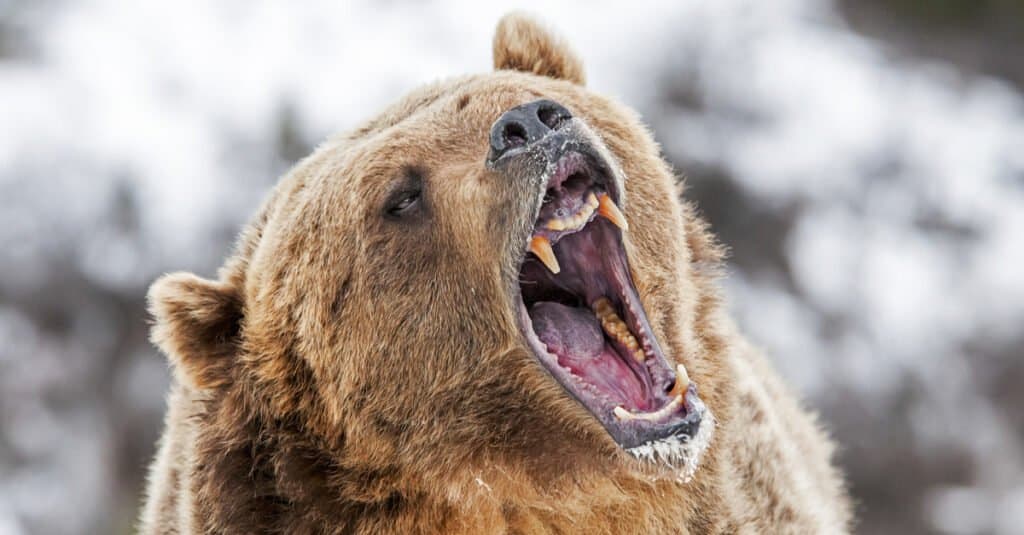
Grizzly bears are one of the most dangerous animals in Washington. They can weigh 400-800 lbs or more!
©Scott E Read/Shutterstock.com
Yes, there are bears in Washington state! Black bears are the most common while grizzly bears are a more rare sight.
- Grizzly bears: Washington is one of the few states that still have Grizzly bears. They can only be found in few places like the Selkirk Mountains and a few areas along the border with Canada. They are listed as an endangered species in the state. Grizzly bears are the second largest bears, with polar bears being the largest. Grizzlies can weigh between 400-800 lbs and be 3.3 feet at the shoulder. If you do come across one of these enormous bears in the wild slowly back away and hope they do not notice you. Bear attacks are very rare with only 14 recorded bear attacks and one fatality in the state. Carrying bear spray when you are in bear country can help keep you safer.
- Black bears: Black bears are common throughout Washington and can be found in the coastal forests and in the Cascade Mountains. There are nearly 25,000-30,000 bears in the state. Black bears are smaller than Grizzlies and less aggressive but they can attack if they are protecting their cubs or feel threatened. On July 4, 2017 a woman and her two dogs were attacked by a Black bear near the Priest Lake visitor center. She was hiking in the woods on a trail that her family was used to hiking when one of the dogs was bit and then it came after her. She was airlifted to the nearest hospital where she was treated and released suffering many gashes but surviving.
What venomous (poisonous) snakes can be found in Washington?

Western
rattlesnakes
can be found in the eastern half of Washington state.
©Tom Reichner/Shutterstock.com
Washington is home to just one species of venomous snake, the western rattlesnake. This snake can also be found in Idaho and much of the Pacific Northwest. It’s a common sight across much of Eastern Washington, but isn’t found in Western Washington. Which is to say, if you’re bitten by a snake along the Puget Sound basin, it’s almost certainly not venomous.
Venomous snakes can be dangerous animals, but there are not very many in Washington. In the US, there are around 7,000-8,000 venomous snake bites per year but only an average of 5 people die per year due to bites. If you see a questionable snake, slowly walk away, Snakes typically want to be left alone and rattlesnakes will rattle their tail as a warning. Do not pick up a snake! Most bites occur when people try to handle or move a snake. If you do get bit you should seek immediate medical treatment.
Are there “Murder Hornets” in Washington?
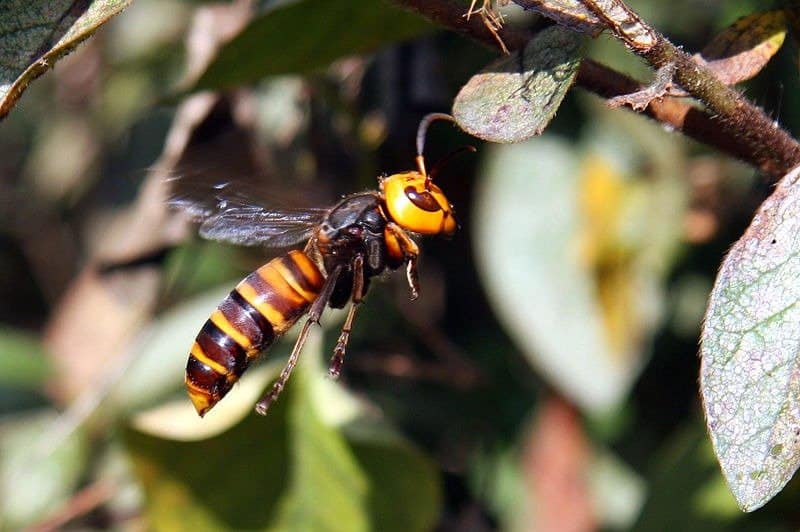
Asian giant hornets are deadly to honeybees but typically stay away from humans.
©Fufill / CC BY-SA 3.0 – License
Murder hornets definitely sound dangerous but they are more dangerous to honeybees than humans. In 2019 the first Murder hornet (Asian giant hornets) were found in Washington state for the first time. This is a huge concern because these hornets can wipe out entire honeybee populations. Swarms of them invade a hive, kill the honeybees and move in. In the summer of 2021 four of these nests were found and destroyed, hoping that all the Asian giant hornets had been destroyed. It will be two years before we know if they got them all.
Are “Murder Hornets” the most dangerous animal in Washington?
Murder hornets are dangerous to honeybees but according to the Washington State Agriculture Department, “they do not generally attack people or pets.” With there being so few in Washington, or hopefully gone, they are not a big threat in Washington. However, in Japan, where these hornets are native, they are responsible for 30-50 fatalities a year. So Murder hornets are dangerous, but not the most dangerous in Washington.
Summary of the Most Dangerous Animals in Washington state
Here are 10 of the most dangerous animals in Washington state!
| Rank | Animal |
|---|---|
| 1 | Great white sharks |
| 2 | Blue sharks |
| 3 | Salmon sharks |
| 4 | Grizzly bears |
| 5 | Black bears |
| 6 | Asian giant hornets (invasive) |
| 7 | Western rattlesnake |
| 8 | Mountain lions |
| 9 | Bobcats |
| 10 | Wolves |
Bonus: How Dangerous are Bobcats to Humans?
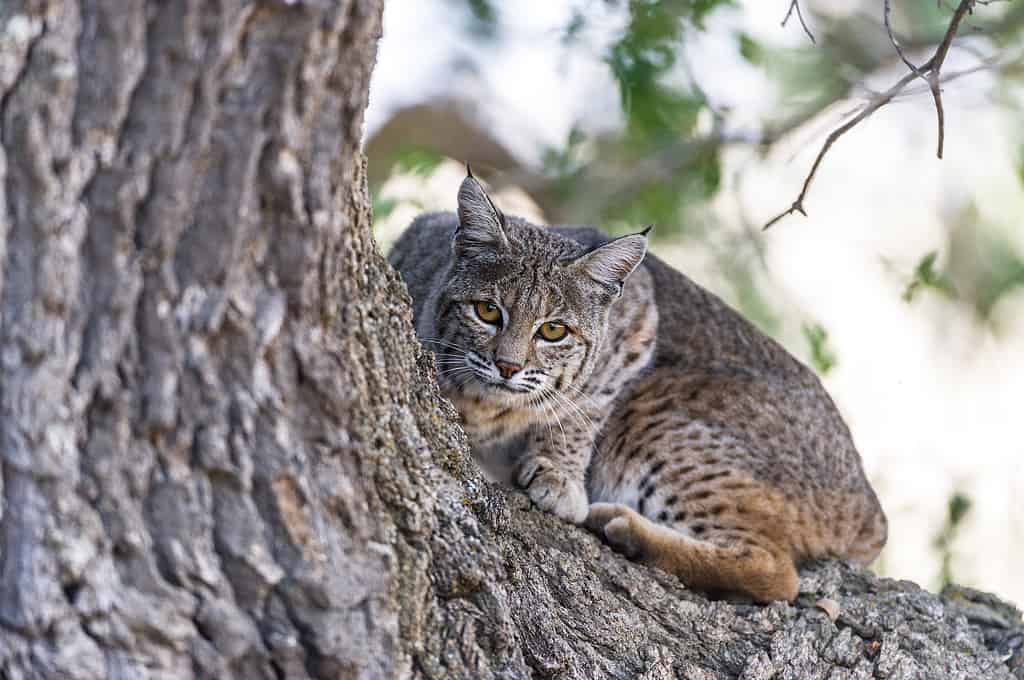
It’s very rare for a
bobcat
to attack a human, but they will prey on small, unattended pets if given the chance.
©iStock.com/brentawp
While bobcats made the top 10 list of most dangerous animals in Washington state, you may be wondering what kind of threats they pose. Are bobcats dangerous to humans? If so, how often do they attack?
Bobcats (also called lynxes) are one of the smallest types of wildcats, typically weighing between 15 to 40 lbs. Sometimes bobcats are comparable in size to larger domestic cats, weighing up to 20 lbs. Due to their size, they feed on smaller prey like rabbits, birds, squirrels, rats, and chickens. They would not likely view a large human in terms of a potential meal. However, they can be drawn to yards by unattended small pets, which are attractive prey to bobcats.
Other things that can attract bobcats to your property include:
- Bird baths
- Pools
- Fountains
- Water for livestock
- Food for livestock
- Space underneath decks
- Thick brush and shade
- Unoccupied yards to sunbathe in
Bobcats usually run away from a human. If you encounter one, the best thing to do is face the bobcat, stand your ground (don’t flee), and make noise. Do not, however, purposefully approach a bobcat. If a bobcat boldly approaches you, it may have rabies. While reports of bobcat attacks on humans hardly exist, there was a resident of Saddlebrooke, Arizona, who suffered a bobcat attack. Authorities believed it to be rabid, but it was not successfully captured to prove as much. The man bitten was forced to undergo a full round of rabies treatments to protect him from potential infection.
In summation, bobcats do not pose a serious threat to humans. As long as you react appropriately if an encounter with a bobcat occurs, you’ll likely walk away unscathed.
The photo featured at the top of this post is © ovbelov/Shutterstock.com
Thank you for reading! Have some feedback for us? Contact the AZ Animals editorial team.






